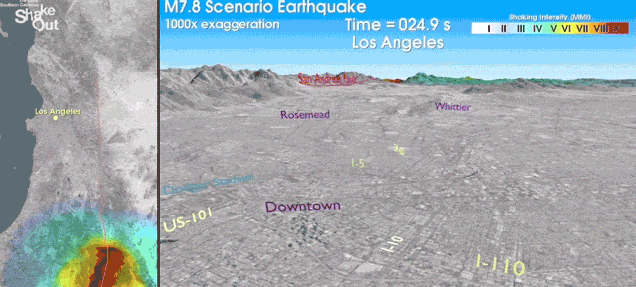Everyone’s fretting about a terrifying article on the terrifying Cascadia Subduction Zone, which will almost certainly deliver the deadliest earthquake in US history. That earthquake would almost certainly be made less deadly with an early warning system that’s ready to be implemented — if only the US would decide to make it a priority.
Certainly it is not news to seismologists that an earthquake on this subduction zone will be so powerful that it could snap off the western eighth of North America and plunge it into the sea. (Not really exaggerating too much!) For years they have been trying to tell us that the biggest US quake isn’t coming from San Andreas Fault, which isn’t even capable of producing anything bigger than an 8.2. In fact, one of the most prominent ones said it a few weeks ago.
So that’s why stories like this week’s beautifully written one are good — they get people thinking about how to prepare for an earthquake. (And in some ways, so do movies starring The Rock.) This usually includes reminders about what to do (and what not to do), the plans to make with your friends and family, and how to prepare a kit that will keep yourself alive for a few days if help can’t get to you.
Personal preparation for a quake is good, but an early warning system is different in that it has the potential to save many more lives by quickly executing large-scale changes across a city. That’s why a group of researchers at USGS, Caltech, UC Berkeley and other institutions have worked together on a prototype that can detect the shaking when and where it starts and send an alert that travels faster than the seismic waves.

The time it would take for shaking to reach LA after a 7.8 quake 150 miles away
The system could give some cities up to a minute of advance warning. It might not sound like a lot, but in many cases that’s enough time to stop a train and prevent a derailment or mitigate the potentially catastrophic effect of an earthquake on a nuclear reactor.
Earlier this year, Obama proposed $US5 million for a West Coast-based system and certain California legislators have echoed that more than $US16 million is needed. However, even though hundreds of lives could be saved in a major earthquake if the system was deployed, Congress has still not allocated enough funding to make this happen.
But maybe even more importantly for those in the Pacific Northwest who are now traumatized by the idea of their neighbourhoods turning into geological Jell-O: Early warning systems also offer an emotional benefit to the people who use them. Countries like Japan and Mexico have turned their early warning systems into mobile apps, and studies have shown that these help give people more peace of mind just by having the app on their phones. I didn’t think about the benefits much until I had a kid, but now you better believe I want those extra 20 seconds to be able to think clearly about what’s about to happen and possibly get us both to a safe place by the time the shaking starts.
So. Get scared by the facts, tweet some funny jokes about Portland falling into the Pacific Ocean, but take a few moments to tell your local congressperson you want an earthquake early warning system, no matter where you live. We know about the risk in the Northwest. But earthquakes are showing up in some unusual places nowadays.
